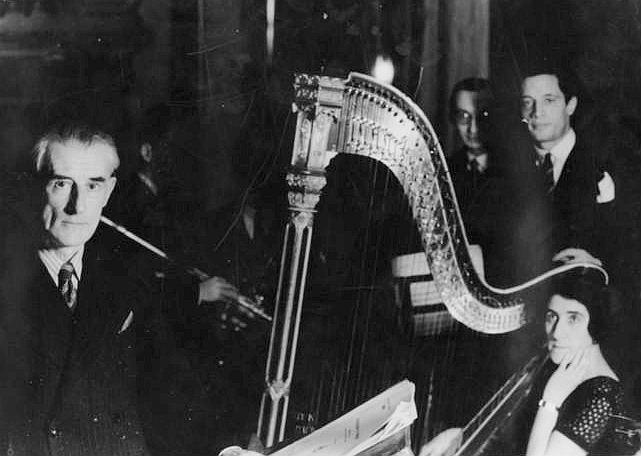 | ||
Introduction and Allegro for Harp, Flute, Clarinet and String Quartet (French: Introduction et allegro pour harpe, flûte, clarinette et quatuor) was written by Maurice Ravel in 1905. It premiered on 22 February 1907 in Paris.
Contents
Background
To show off its new chromatic harp, the Pleyel company commissioned Claude Debussy in 1904 to write his Danse sacrée et danse profane for harp and orchestra. The Érard company responded by commissioning Maurice Ravel to write a piece to display the expressive range of its double-action pedal harp. Ravel completed his Introduction and Allegro for a septet of harp, flute, clarinet and string quartet in June 1905, dedicating it to Albert Blondel, director of Maison Érard. He wrote it at breakneck speed, as he had to complete it before embarking on a boating holiday with friends.
Ravel omitted the Introduction and Allegro from the catalogue of his works, made no mention of it in his autobiography, and referred to it in only two of his letters. Nevertheless, it was often performed at his concerts and it was the very first of the small number of his own works that Ravel recorded (1923; Gwendolen Mason, harp; Robert Murchie, flute; Haydn P. Draper, clarinet.)
In 1906 Ravel wrote a version for two pianos. In a letter to Désiré-Émile Inghelbrecht on 26 February 1911, Ravel sanctioned the work being arranged for larger forces.
Description
It is written in the key of G-flat major and it is the first piece to explore and exploit the full resources of the solo instrument. It is sometimes described as a miniature concerto, but it is more usually classified as a genuine chamber music work.
The Introduction and the Allegro are played without a break. The Introduction, Très lent, takes only 26 bars. The Allegro in a modified sonata form begins with the solo harp expanding the material presented before. The woodwinds expose a second theme, accompanied by pizzicato. After a fortississimo climax in the development, a harp cadenza leads to a "straightforward" recapitulation and a close "without extensive fireworks or bombast of any kind". The work takes about 11 minutes to perform.
Premieres
The premiere took place on 22 February 1907 at the Circle Music Hall of the French Photographic Society in Paris, featuring Micheline Kahn (harp), Philippe Gaubert (flute), M. Pichard (clarinet), and the Quartet Firmin Touche, all under the direction of Charles Domergue.
It was premiered in the United States by a group including the harpist Carlos Salzedo. Salzedo's then-wife Lucile Lawrence, also a harpist, was personally instructed by Ravel in the performance of the work.
Recordings
Later recordings include:
The work was also performed on television, on the 23 December 1963 edition of Leonard Bernstein's Young People's Concerts.
